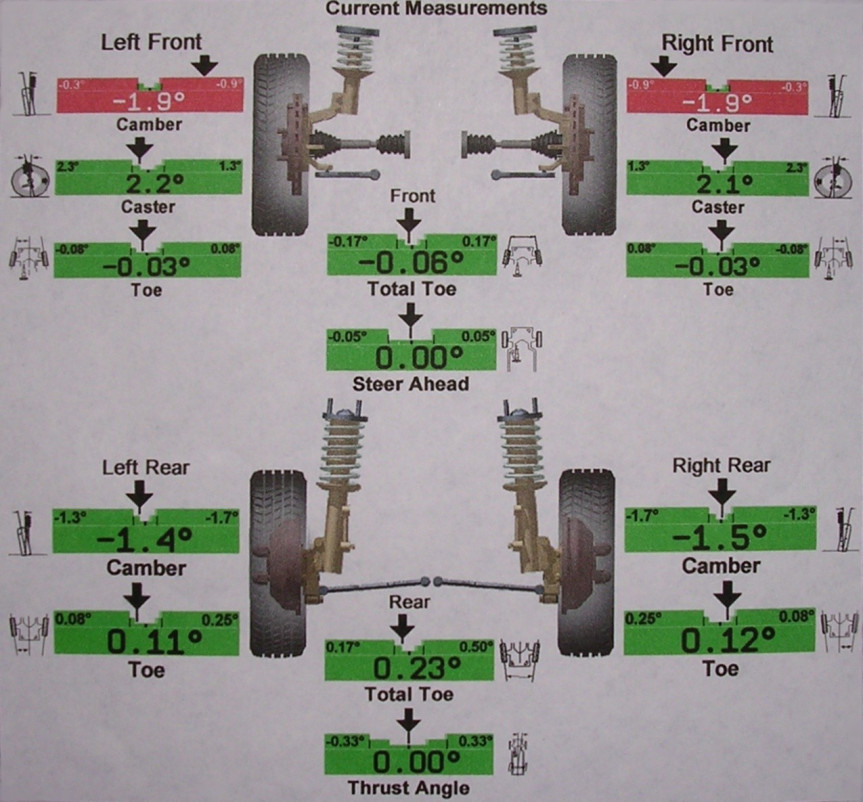An important part of keeping an Audi or Volkswagen well-maintained and operating correctly is the vehicle's wheel alignment. This is one of the few repairs that must be performed by a professional, and with good reason. Performing an alignment will make sure the wheels are “square” with each other in order to keep the vehicle tracking properly, and to reduce tire wear. Sophisticated computer software is required to take very accurate measurements of the wheels of a car, and a trained technician needs to make adjustments to properly align it.
If your feet point out, that's toe-out.
There are three measurements that affect the alignment of a car: Toe, camber, and caster. Toe is the angle of the tires relative to the center line of the vehicle – think of it like your feet. If you're pigeon toed, you have toe-in, and if your feet point out, that's toe-out. Camber is the angle of the wheel relative to the vertical axis of the car. If the bottom of the tire sticks out past the top, it's negative, and if it's the other way around, it's positive. The final measurement, caster, refers to the angle of the axis on which the front wheels pivot. Imagine your front struts are a perfectly straight vertical line. Moving the top point of your strut forward or backward will affect your caster angle. Think of the front forks on a chopper motorcycle – the angle that they lean back is caster.
All three measurements are important not only for handling but tire wear. If a vehicle has too much camber, negative or positive, the outer edges of the tire will wear, due to uneven contact with the road. If your toe is off, the tires will “scrub” causing uneven tire wear in the form of feathering.
Alignments should be performed regularly. I think alignments should be done every one or two years, but it all depends on driving habits and mileage. Every time tires are replaced, an alignment should be done – unless one was just recently done.
Any time major suspension components are replaced, like shocks, springs, and control arms, an alignment should be done. Your alignment may not be off after repairs, true, but it's a lot cheaper to buy an alignment now than tires in six months. If you're planning on lowering your car, you absolutely need to set aside in your budget an alignment.
 An example of negative camber
An example of negative camber
Front camber isn't adjusted independently on some cars
Alignments are different on different cars. Typically, the front toe and camber are adjustable, and sometimes caster. Models with independent rear suspension have adjustable rear toe and camber, but rear beams can't be moved with great results – VW and Audi don't specify a rear camber or toe adjustment. On newer VW and Audis, front camber isn't adjusted independently on each side. The entire front subframe is shifted, and camber is equalized from side to side. This setup isn't ideal in my opinion, but it works.
Now, an alignment alone isn't enough to eliminate bad tire wear. Make sure your suspension is in good shape before getting an alignment done. If your rear shocks are blown out, you'll get cupped and noisy tires – no good. If your tie rods (which adjust toe) have play, they'll need to be replaced before doing an alignment.
I'm cheap. The major reason I recommend alignments is because tires are so expensive. They're like K cups. Unless they're on clearance, they're always slightly more than you think you should pay. The best way to save money on tires is to spend money on an alignment.
Shop Volkswagen Suspension at FCP Euro
About the Author: Chris Stovall
 Chris is a journeyman mechanic from Berkeley, California, specializing in late model Volkswagens and Audis. A glutton for punishment, his spare time is spent rebuilding every component of his '83 Rabbit GTI.
Chris is a journeyman mechanic from Berkeley, California, specializing in late model Volkswagens and Audis. A glutton for punishment, his spare time is spent rebuilding every component of his '83 Rabbit GTI.












